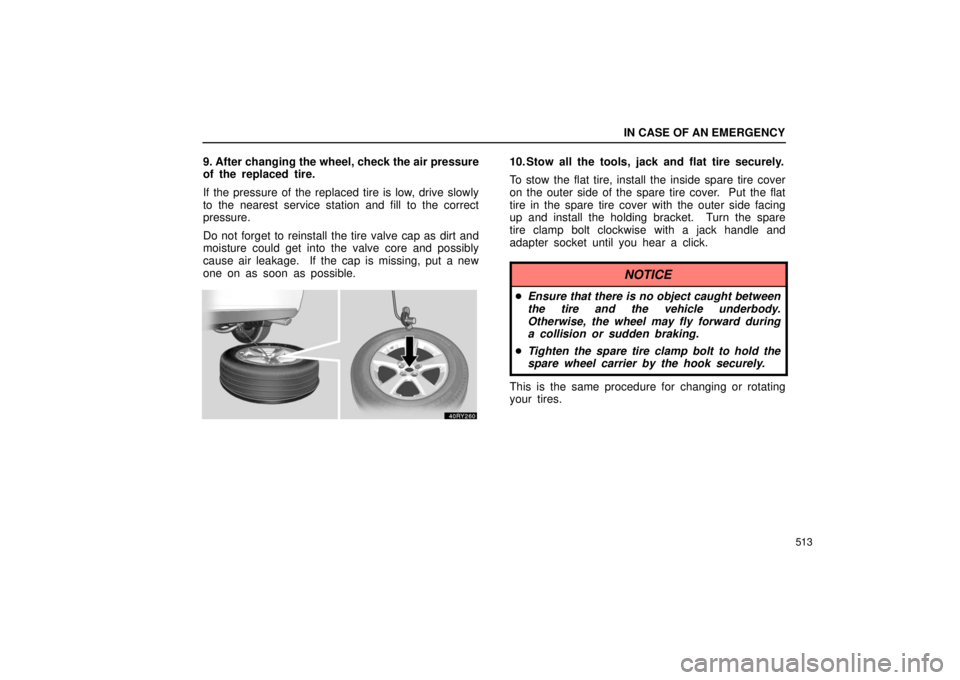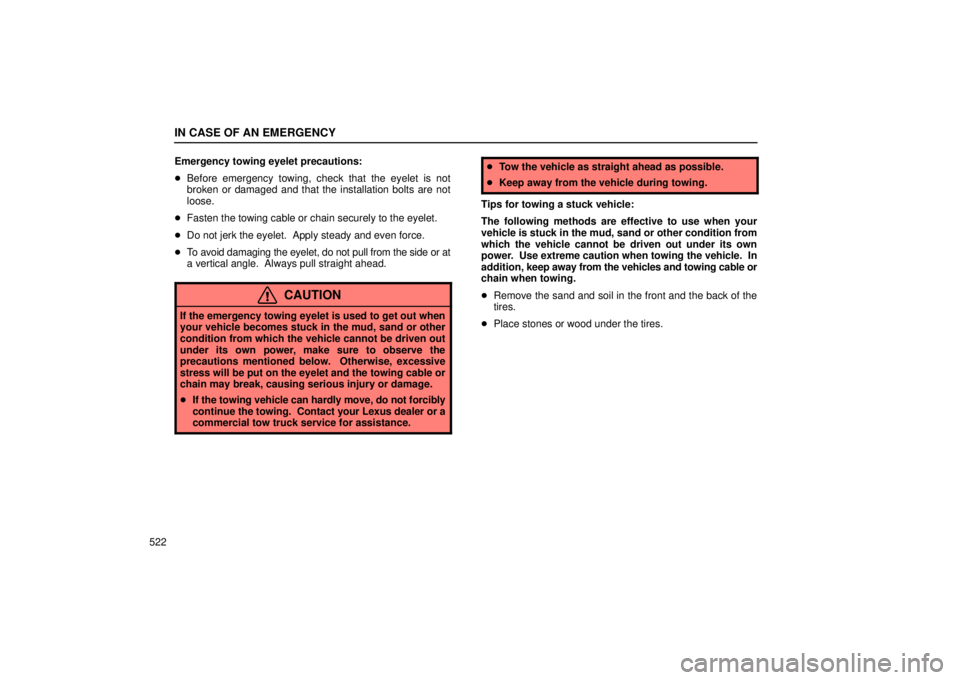Page 524 of 651
IN CASE OF AN EMERGENCY
503
To get the required tools:
1Pull up the front deck board.
2Hold the front deck board by the supporting rod.
Make sure the board is secured and does not fall
down.
When closing the board, replace the supporting rod
also in its original position as shown.
Page 525 of 651
IN CASE OF AN EMERGENCY
504
To remove the jack, unhook the tightening strap.
To store the jack, make sure it is securely held by
the tightening strap.�1Joint
2When removing the jack, turn the joint by hand
in the “contract” direction until the jack is free.
3When storing, turn the joint by hand in the
“expand” direction until the jack is firmly
secured to prevent it from flying forward during
a collision or sudden braking.
Page 533 of 651

IN CASE OF AN EMERGENCY
512
8. Lower the vehicle completely and tighten the
wheel nuts.
Turn the jack handle counterclockwise to lower the
vehicle.
Use only the wheel nut wrench to tighten the nuts.
Do not use other tools or any additional leverage other
than your hands, such as a hammer, pipe or your foot.
Make sure the wrench is securely engaged over the
nut.
Tighten each nut a little at a time in the order shown.
Repeat the process until all the nuts are tight.
CAUTION
�When lowering the vehicle, make sure all
portions of your body and all other persons
around will not be injured as the vehicle is
lowered to the ground.
� Have the wheel nuts tightened with torque
wrench to 103 N·m (10.5 kgf·m, 76 ft·lbf), as
soon as possible after changing wheels.
Otherwise, the nuts may loosen and the
wheels may fall off, which could cause a
serious accident.
� Do not attach a heavily damaged plastic wheel
ornament. It may fly off the wheel and cause
accidents while the vehicle is moving.
Page 534 of 651

IN CASE OF AN EMERGENCY
513
9. After changing the wheel, check the air pressure
of the replaced tire.
If the pressure of the replaced tire is low, drive slowly
to the nearest service station and fill to the correct
pressure.
Do not forget to reinstall the tire valve cap as dirt and
moisture could get into the valve core and possibly
cause air leakage. If the cap is missing, put a new
one on as soon as possible.10. Stow all the tools, jack and flat tire securely.
To stow the flat tire, install the inside spare tire cover
on the outer side of the spare tire cover. Put the flat
tire in the spare tire cover with the outer side facing
up and install the holding bracket. Turn the spare
tire clamp bolt clockwise with a jack handle and
adapter socket until you hear a click.
NOTICE
�Ensure that there is no object caught between
the tire and the vehicle underbody.
Otherwise, the wheel may fly forward during
a collision or sudden braking.
� Tighten the spare tire clamp bolt to hold the
spare wheel carrier by the hook securely.
This is the same procedure for changing or rotating
your tires.
Page 535 of 651
IN CASE OF AN EMERGENCY
514
CAUTION
Before driving, make sure all the tools, jack and
flat tire are securely in place in their storage
location to reduce the possibility of personal
injury during a collision or sudden braking.
IF YOUR VEHICLE BECOMESSTUCK
If your vehicle becomes stuck in snow, mud, sand, etc.,
then you may attempt to rock the vehicle free by moving
it forward and backward.
Two�wheel drive models — Turn off the traction control
system to become unstuck to allow the tires to spin
enough to remove the vehicle from the obstruction. (For
details, see “Traction control system” on page 449.)
CAUTION
Do not attempt to rock the vehicle free by moving it
forward and backward if people or objects are anywhere
near the vehicle. During the rocking operation the
vehicle may suddenly move forward or backward as it
becomes unstuck, causing injury or damage to nearby
people or objects.
Page 541 of 651
IN CASE OF AN EMERGENCY
520
(c) Towing with a sling type truck
NOTICE
Do not tow with a sling type truck, either from the front
or rear. This may cause body damage.
(d) Emergency towing
If towing is necessary, we recommend you to have it done
by your Lexus dealer or a commercial tow truck service.
If towing service is not available in an emergency, your
vehicle may be temporarily towed by a cable or chain
secured to the emergency towing eyelet on the front of the
vehicle. Use extreme caution when towing the vehicle.
To install the front towing eyelet, see “(e) Installing front towing
eyelet” on page 523.
Page 542 of 651

IN CASE OF AN EMERGENCY
521
NOTICE
�Only use specified towing eyelet; otherwise your
vehicle may be damaged.
� Never tow a vehicle from the rear with four wheels on
the ground. This may cause serious damage to the
transmission.
A driver must be in the vehicle to steer it and operate the
brakes.
Towing in this manner may be done only on hard −surfaced
roads for a short distance and at low speeds. Also, the wheels,
axles, drive train, steering and brakes must all be in good
condition.
CAUTION
Use extreme caution when towing the vehicle. Avoid
sudden starts or erratic driving maneuvers which would
place excessive stress on the emergency towing eyelet
and towing cable or chain. The eyelet and towing cable
or chain may break and cause serious injury or damage.
NOTICE
Use only a cable or chain specifically intended for use
in towing vehicles. Securely fasten the cable or chain
to the towing eyelet provided.
Before towing, release the parking brake and put the
transmission in “N”. The ignition key must be in “ACC” (engine
off) or “ON” (engine running).
CAUTION
If the engine is not running, the power assist for the
brakes and steering will not work so steering and
braking will be much harder than usual.
Page 543 of 651

IN CASE OF AN EMERGENCY
522Emergency towing eyelet precautions:
�
Before emergency towing, check that the eyelet is not
broken or damaged and that the installation bolts are not
loose.
� Fasten the towing cable or chain securely to the eyelet.
� Do not jerk the eyelet. Apply steady and even force.
� To avoid damaging the eyelet, do not pull from the side or at
a vertical angle. Always pull straight ahead.
CAUTION
If the emergency towing eyelet is used to get out when
your vehicle becomes stuck in the mud, sand or other
condition from which the vehicle cannot be driven out
under its own power, make sure to observe the
precautions mentioned below. Otherwise, excessive
stress will be put on the eyelet and the towing cable or
chain may break, causing serious injury or damage.
�If the towing vehicle can hardly move, do not forcibly
continue the towing. Contact your Lexus dealer or a
commercial tow truck service for assistance.
�Tow the vehicle as straight ahead as possible.
� Keep away from the vehicle during towing.
Tips for towing a stuck vehicle:
The following methods are effective to use when your
vehicle is stuck in the mud, sand or other condition from
which the vehicle cannot be driven out under its own
power. Use extreme caution when towing the vehicle. In
addition, keep away from the vehicles and towing cable or
chain when towing.
� Remove the sand and soil in the front and the back of the
tires.
� Place stones or wood under the tires.